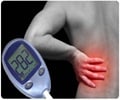- 10 Superfood that can lower blood sugar level
- Tips to use these 10 superfoods
- Do’s and don’ts for diabetic patients
Walnuts Can Increase Good Cholesterol Decrease Bad cholesterol & Lower Blood Sugar
Walnuts are the perfect combination of fiber, protein, and healthy fats that makes them a great snack. The fatty acids help in increasing the good cholesterol while decreasing bad cholesterol. This may reduce the risk of heart disease or heart attack. In a 2012 study it was observed that people who consumed Walnuts at least twice a week appeared to have a lower risk of gaining weight than those who never or rarely ate nuts (1✔ ✔Trusted SourceNut consumption and weight gain in a Mediterranean cohort: The SUN study
Go to source).
Tips for use
- You can crush and add it to your yogurt, oats, breakfast cereal, or salad.
- You can make a trail mix treat with walnuts as a part of it.
Avocado Can Reduce Risk of Diabetes and is a Rich Source of Vitamin E
Avocados are a great source of healthy fats and vitamins.Avocado is high in fiber and as per researches it has been noted that high fiber intake can significantly lower risk of diabetes and its complications. Avocado is also a rich source of vitamin E that is known to reduce the risk of diabetic linked diseases (2✔ ✔Trusted SourceVitamin E, Its Beneficial Role in Diabetes Mellitus (DM) and Its Complications
Go to source).
Tips for use
- You can replace the butter on your toast with avocado spread.
- Avocado can be used instead of mayonnaise in your salad.
Ezekiel bread can Improve Metabolism of Sugar
Ezekiel Bread is one of the healthiest options of bread available. It is made with sprouted grains and is rich in protein, vitamin B, minerals and antioxidants. An article published in the Journal of Nutrition and Metabolism observes that sprouted-grains improves blood sugar response (3✔ ✔Trusted SourceThe acute impact of ingestion of sourdough and whole-grain breads on blood glucose, insulin, and incretins in overweight and obese men
Go to source).
Tips for use
- You can replace your normal bread to Ezekiel bread.
Pumpkin seeds are a Rich Source of Magnesium that Helps in Maintaining Diabetes.
Pumpkin seeds are a good source of magnesium, fiber and healthy fatty acids. People with insulin resistance tend to suffer with low magnesium levels. Thus, incorporating in our daily lives can help with maintaining fair levels of magnesium in the body (4✔ ✔Trusted SourceRole of Minerals and Trace Elements in Diabetes and Insulin Resistance
Go to source).
Tips for use
- You can toast your pumpkin seed and top it on your salads and add it to your trail mix.
- You can blend the pumpkin seeds to make butter out of it.
Strawberries are High in Antioxidants & Helps Prevent Diabetes Complications
Strawberries are rich in vitamins and are an excellent source of antioxidants. As per a study published in 2011, it was noted that ’fisetin’, a substance contained in strawberries, prevented both kidney and brain complications in mice with diabetes (5✔ ✔Trusted SourceFisetin lowers methylglyoxal dependent protein glycation and limits the complications of diabetes
Go to source).
Use with caution:
A cup of strawberries contains just over 7 g of sugar. People with diabetes should avoid adding sugar to strawberries.
Tips for use
- Make a superfood salad by mixing strawberries, pumpkin seeds, spinach, and walnuts.
- Strawberry smoothie with milk and peanut butter.
Chia Seeds Helps Reduce Risk of High blood sugar
Chia seeds are rich in antioxidants, omega-3-fatty acids, fiber, and magnesium. All of these may help in reducing the risk of type 2 diabetes and diabetes complications (6✔ ✔Trusted SourceChia seed ( Salvia hispanica L.) supplementation to the diet of adults with type 2 diabetes improved systolic blood pressure: A randomized controlled trial
Go to source).
Tips for use
- Chia seed can be soaked overnight in milk to make chia seed pudding.
- Chia seeds can substitute eggs in baking by mixing 1 tablespoon of Chia with 3 tablespoons of water and letting the mixture sit for a few minutes.
- They can be added in your salad and toast.
Ginger is an Excellent Source of Antioxidants that Reduces Fasting Blood Sugar
Ginger is considered to be an excellent food for diabetic patients. They are high in antioxidants are sometimes called anti-inflammatory foods and can help in treating the symptoms and reduce the long-term risks of diseases such as diabetes. Even though studies on ginger and diabetes are limited. Some researches state that ginger can reduce fasting blood sugar levels and improve insulin sensitivity in people with type 2 diabetes. In another research published in 2014, concluded that there is a reduction of blood sugar levels in people who took three 1-gram capsules of ginger each day for 8 weeks (7✔ ✔Trusted SourceThe effect of ginger powder supplementation on insulin resistance and glycemic indices in patients with type 2 diabetes: a randomized, double-blind, placebo-controlled trial
Go to source).
Tips for use
- Ginger can be consumed in the form of tea
- Fresh or dried ginger can be added to stir-fry or homemade salad dressing.
Spinach are Packed with Potassium and helps Lower Blood Sugar
Spinach is rich in potassium, fiber, iron and antioxidants. Researchers have associated intake of spinach with lowering of blood sugar level in diabetic patients due to it’s high potassium content (8✔ ✔Trusted SourcePotassium and risk of Type 2 diabetes
Go to source).
Tips for use
- Spinach can be made into a smoothie.
- Spinach can replace lettuce in burgers and sandwiches.
Cinnamon Reduce Blood Sugar and Excess Weight
Cinnamon is known to reduce blood sugar levels for people with diabetes. Authors of a 2019 study published in Clinical Nutrition found that people with diabetes who used cinnamon supplementation had great improvements in body mass index (BMI), blood sugar levels, and lipid levels than those who did not (9✔ ✔Trusted SourceEfficacy of cinnamon in patients with type II diabetes mellitus: A randomized controlled clinical trial
Go to source).
Tips for use
- Cinnamon can be mixed into tea or warm milk.
- Sprinkle cinnamon on oatmeal or apple instead of sugar.
Tomatoes Reduces the Risk of Heart Disease and Diabetes
Tomatoes can help to reduce blood pressure for people with diabetes. A study published in 2010 found that people with diabetes who ate just 200 g of tomatoes had lower blood pressure after 8 weeks. They concluded that eating tomatoes might help reduce the cardiovascular risk that is associated with type 2 diabetes (10✔ ✔Trusted SourceThe effects of tomato consumption on serum glucose, apolipoprotein B, apolipoprotein A-I, homocysteine and blood pressure in type 2 diabetic patients
Go to source).
Tips for use
- Make tomato soup
- Add it to your salad and sandwiches
Do's and Dont's for Diabetic Patients
- Eat every 2 hours : this will help you to regulate your sugar levels.
- Include the superfoods in every meal
- Say no to quick-digesting carbohydrates: Instead of white bread and pasta that digests quickly, go for slower-digesting carbohydrates with extra nutrients like vegetables, whole grains, beans, and berries.
- Know a food’s GI score: Foods with a lower GI score raise blood sugar levels and makes you feel fuller for longer. They include oatmeal, muesli, and non-starchy vegetables.
- Limit high-GI foods: Avoid white bread, sugar, and cornflakes.
- Nut consumption and weight gain in a Mediterranean cohort: The SUN study - (https://pubmed.ncbi.nlm.nih.gov/17228038/)
- Vitamin E, Its Beneficial Role in Diabetes Mellitus (DM) and Its Complications - (https://pubmed.ncbi.nlm.nih.gov/23373014/)
- The acute impact of ingestion of sourdough and whole-grain breads on blood glucose, insulin, and incretins in overweight and obese men - (https://pubmed.ncbi.nlm.nih.gov/22474577/)
- Role of Minerals and Trace Elements in Diabetes and Insulin Resistance - (https://pubmed.ncbi.nlm.nih.gov/32585827/)
- Fisetin lowers methylglyoxal dependent protein glycation and limits the complications of diabetes - (https://pubmed.ncbi.nlm.nih.gov/21738623/)
- Chia seed ( Salvia hispanica L.) supplementation to the diet of adults with type 2 diabetes improved systolic blood pressure: A randomized controlled trial - (https://pubmed.ncbi.nlm.nih.gov/33530854/)
- The effect of ginger powder supplementation on insulin resistance and glycemic indices in patients with type 2 diabetes: a randomized, double-blind, placebo-controlled trial - (https://pubmed.ncbi.nlm.nih.gov/24559810/)
- Potassium and risk of Type 2 diabetes - (https://www.ncbi.nlm.nih.gov/pmc/articles/PMC3197792/)
- Efficacy of cinnamon in patients with type II diabetes mellitus: A randomized controlled clinical trial - (https://pubmed.ncbi.nlm.nih.gov/29605574/)
- The effects of tomato consumption on serum glucose, apolipoprotein B, apolipoprotein A-I, homocysteine and blood pressure in type 2 diabetic patients - (https://pubmed.ncbi.nlm.nih.gov/21138408/)
Source-Medindia















